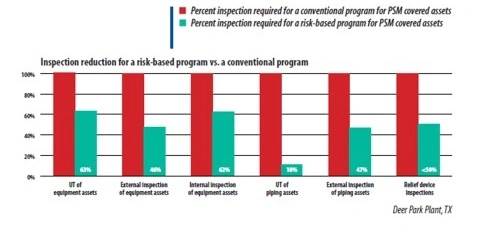Reliability Revolution - Measuring the Value of an RBI Program
Register
Nothing is scheduled at this time.
Request more information about when this course will be scheduled or inquire about our on-site training.
Overview

How do you measure success?
Perhaps the most impressive measures of success as reported from a number of refining and chemical manufacturers are the value from two related yet completely decoupled measurements: risk reduction and recordable incidents.
This 60-minute lunch and learn will take you through actual case studies where the measured value of these two items alone exceeded hundreds of millions USD in just a few years while recordable incidents dropped as much as 87 percent following the year the RBI program was completed. We will also provide you a scorecard and template for calculating your own value proposition for implementing an RBI program at your site or enterprise. In addition, we will show you the steps in preparing the value contribution from your asset integrity program to meet your corporate goal for return on net assets.
Other reported benefits include:
- Increased uptime and less production losses due to fewer internal inspections and relief device tests
- Nearly $5 million inspection labor saved during RBI implementation
- Ongoing inspection labor savings of $1 million per year
- The financial benefits by way of risk reduction for the refinery for the FCC block, over a ten year period, was estimated to be $13,510,000. Risk reduction is expected to improve uptime by 0.5 - 1% and reduce high potential incidents
- Less incidents and releases that can affect your employees and our neighbors=less money spent on clean-up, remediation, and health related costs due to exposures and litigation
- Increased Operational Asset Utilization (OAU) for the site=lower lost production cost due to leaks and/or releases
- Lowered reactive maintenance cost=less reactive jobs, less specialized outside contractors (i.e. Team Inc., etc.), and less support activities (i.e. scaffolding, stress relief, etc.)
- Helped reduce the HPIs by over 60 percent: "Fifty-eight HPIs were recorded in the 5 years (1997-2001) prior to 2002 implementation. Fourteen (14) HPIs have been recorded between 2003 and 2006 (after the program was in place). On average it looks like the RBI Program has helped reduce the HPIs by over 60%," RMC-07-96 Assessing the Value Creation of RBI John Aller Lloyd's Register Capstone; Karen Maxson, DuPont Engineering Reliability and Maintenance Conference and Exhibition May 22-25, 2007 George R. Brown Convention Center, Houston, TX
- Significant improvements in reliability lead to a measured 96.7 percent asset mechanical reliability
- Fostering a sense of "Proud Ownership" by all the employees because they know that the facility is taking reasonable and required steps to ensure their safety and the safety of the community by ensuring that the equipment used in the process is fit for service today as well as tomorrow

Related Services
AOC has delivered thousands of sustainable Risk Based Inspection (RBI) programs earning the trust of owner operators.
One of the most important steps in an RBI project is the corrosion study or damage mechanism review.
When evaluation of inspection results suggest that an asset is near its end of useful life, Fitness for Service evaluations can determine if the asset us suitable for continued operation.
Related Tools
How well do you know RBI? Take this short quiz to test your knowledge of the API 580 risk-based inspection (RBI) work process.
Create mechanical integrity (MI) program value rather than it being seen as a necessary cost to minimize.
Related Training
A high level overview introducing Mechanical Integrity and Risk Based Inspection
What impact does Risk Based Inspection (RBI) have on my organization?
Is your Risk Based Inspection (RBI) program aligned with the API 580 Recommended Practice? Are you ready for certification?
What's actually going on inside all of that fancy software? An introduction to the API 581 methodology.
A deep dive into quantitative Risk Based Inspection (RBI) as outlined in API 581.
Related Knowledge
What are the hidden benefits of implementing Risk Based Inspection?
What are equipment/inspection strategies in relation to mechanical integrity (MI) and risk based inspection (RBI)?
What are the requirements of API 580, 4th edition?
This is a practical approach to incorporating the new PHMSA gas well rules into your integrity program with the rest of your surface and subsurface assets.
A dysfunctionality found in many refineries, chemical plants, and other production facilities, is a lack of common asset management work processes.
A look at how the financial sector's concept of Asset Value Management can be applied to the petrochemical industry.
An example to compliment our earlier proposal for a risk analysis option that allows for individual damage mechanism risk calculation in API 581
A proposal for a risk analysis option that allows for individual damage mechanism risk calculation in API 581
A look at how RBI adds value whether you are just starting out or transitioning from a traditional methodology.
A look at several of the secondary benefits of Risk Based Inspection


Lunch and Learn Inquiry
For more information about this course or to inquire about a customized version of this course hosted in-house at our Houston, Texas location or on-site at a location convenient to you, please complete the form below.